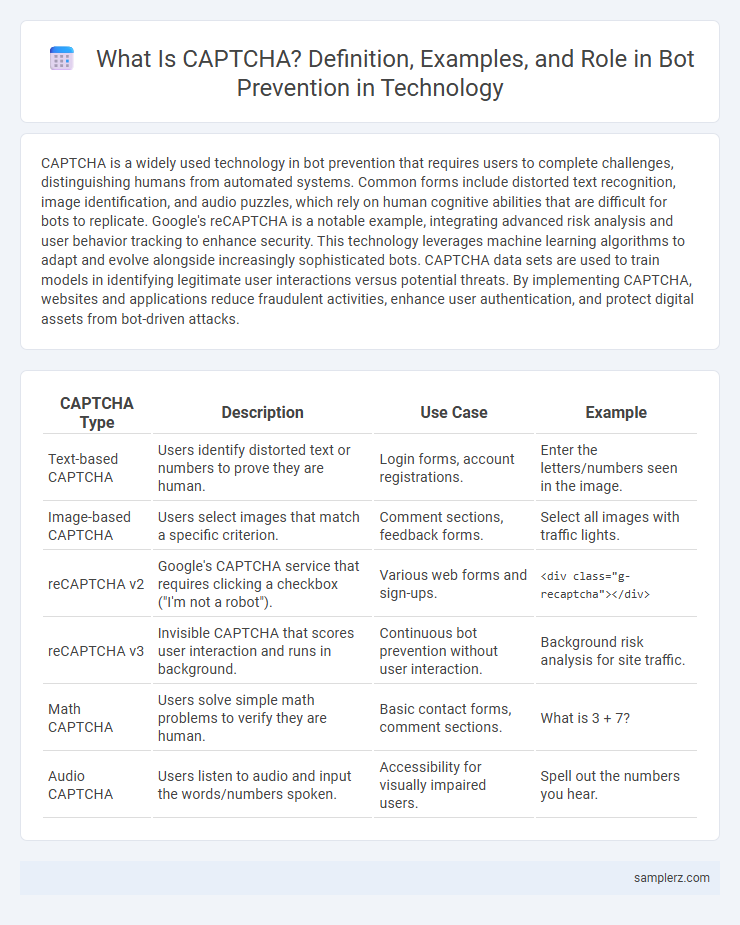CAPTCHA is a widely used technology in bot prevention that requires users to complete challenges, distinguishing humans from automated systems. Common forms include distorted text recognition, image identification, and audio puzzles, which rely on human cognitive abilities that are difficult for bots to replicate. Google's reCAPTCHA is a notable example, integrating advanced risk analysis and user behavior tracking to enhance security. This technology leverages machine learning algorithms to adapt and evolve alongside increasingly sophisticated bots. CAPTCHA data sets are used to train models in identifying legitimate user interactions versus potential threats. By implementing CAPTCHA, websites and applications reduce fraudulent activities, enhance user authentication, and protect digital assets from bot-driven attacks.
Table of Comparison
| CAPTCHA Type | Description | Use Case | Example |
|---|---|---|---|
| Text-based CAPTCHA | Users identify distorted text or numbers to prove they are human. | Login forms, account registrations. | Enter the letters/numbers seen in the image. |
| Image-based CAPTCHA | Users select images that match a specific criterion. | Comment sections, feedback forms. | Select all images with traffic lights. |
| reCAPTCHA v2 | Google's CAPTCHA service that requires clicking a checkbox ("I'm not a robot"). | Various web forms and sign-ups. | <div class="g-recaptcha"></div> |
| reCAPTCHA v3 | Invisible CAPTCHA that scores user interaction and runs in background. | Continuous bot prevention without user interaction. | Background risk analysis for site traffic. |
| Math CAPTCHA | Users solve simple math problems to verify they are human. | Basic contact forms, comment sections. | What is 3 + 7? |
| Audio CAPTCHA | Users listen to audio and input the words/numbers spoken. | Accessibility for visually impaired users. | Spell out the numbers you hear. |
Introduction to CAPTCHA Technology in Bot Prevention
CAPTCHA technology utilizes distorted text or image recognition tasks to differentiate human users from automated bots, enhancing security on websites and online platforms. By presenting challenges that are easy for humans but difficult for machines, CAPTCHA effectively prevents automated spam, unauthorized access, and fraudulent activities. Integration of advanced algorithms, such as machine learning-based image analysis, continuously improves CAPTCHA's ability to thwart increasingly sophisticated bot attacks.
Classic Text-Based CAPTCHA Examples
Classic text-based CAPTCHA examples include distorted letters and numbers that users must identify and input correctly to verify they are human. These CAPTCHAs prevent automated bots from accessing websites by challenging OCR (Optical Character Recognition) algorithms with warped characters, background noise, and varying fonts. Common implementations include retyping skewed alphanumeric strings displayed in images or recognizing letters obscured by lines and color gradients.
Image Recognition CAPTCHA Techniques
Image recognition CAPTCHA techniques require users to identify and select specific objects or patterns within images to verify human interaction and prevent automated bots. These CAPTCHAs enhance security by leveraging machine learning models that challenge bots' inability to accurately interpret complex visual data. Common implementations include selecting all images with traffic lights, cars, or storefronts, effectively distinguishing genuine users from automated scripts.
Audio CAPTCHA for Accessibility
Audio CAPTCHA enhances bot prevention by providing an accessible alternative to visual challenges, enabling users with visual impairments to verify their humanity through sound-based tests. It typically plays a sequence of numbers or letters with background noise to prevent automated recognition while allowing humans to decipher the audio. This approach improves website accessibility compliance and broadens user inclusivity in cybersecurity measures.
Math and Logic Puzzle CAPTCHAs
Math and Logic Puzzle CAPTCHAs require users to solve arithmetic problems or logical reasoning tasks to verify human interaction, effectively blocking automated bots. These puzzles often involve simple equations, pattern recognition, or sequence completion that automated scripts struggle to interpret accurately. Employing Math and Logic Puzzle CAPTCHAs enhances security by leveraging cognitive skills that are difficult for bots to replicate.
reCAPTCHA: Google’s Advanced Solution
Google's reCAPTCHA leverages advanced risk analysis techniques to distinguish between humans and automated bots, enhancing website security without compromising user experience. It employs machine learning algorithms and behavioral analysis, such as monitoring mouse movements and typing patterns, to effectively prevent fraudulent activities and spam. Widely integrated across millions of websites, reCAPTCHA continuously adapts to evolving bot strategies, maintaining robust defense against automated threats.
Invisible CAPTCHA for Seamless User Experience
Invisible CAPTCHA uses advanced risk analysis techniques to differentiate human users from bots without requiring visible challenges, enhancing bot prevention while maintaining seamless user experience. By monitoring user behavior such as mouse movements and keystroke patterns, Invisible CAPTCHA reduces friction during login, form submissions, or account creation. This technology improves security across websites by minimizing false positives and allowing legitimate users to interact without interruption.
Slider and Interactive CAPTCHA Methods
Slider CAPTCHAs enhance bot prevention by requiring users to drag a puzzle piece or slider to match an image, leveraging human motor skills that are difficult for automated bots to replicate. Interactive CAPTCHA methods, such as clicking specific objects or solving simple visual puzzles, increase security by engaging users in tasks that demand human cognitive abilities, reducing false positives and improving user experience. These techniques combine usability with robust verification, making them effective tools against sophisticated automated attacks.
CAPTCHA in Mobile Applications
CAPTCHA implementations in mobile applications often utilize image recognition or puzzle-solving tasks to differentiate human users from automated bots, enhancing security during login or transaction processes. Mobile-specific CAPTCHAs optimize user experience by incorporating touch-based interactions such as sliding or selecting specific objects within an image, reducing input errors on smaller screens. These mobile CAPTCHAs significantly decrease fraudulent activity and unauthorized access, protecting sensitive user data in apps across finance, e-commerce, and social media sectors.
Future Trends in CAPTCHA for Bot Prevention
Advancements in CAPTCHA technology are incorporating artificial intelligence and machine learning to create more adaptive and user-friendly bot prevention systems. Future trends include the integration of behavioral biometrics and invisible CAPTCHA methods that analyze user interactions without disrupting the user experience. Enhanced security measures using multi-factor verification and contextual challenges aim to outsmart increasingly sophisticated automated bots.

example of CAPTCHA in bot prevention Infographic
 samplerz.com
samplerz.com